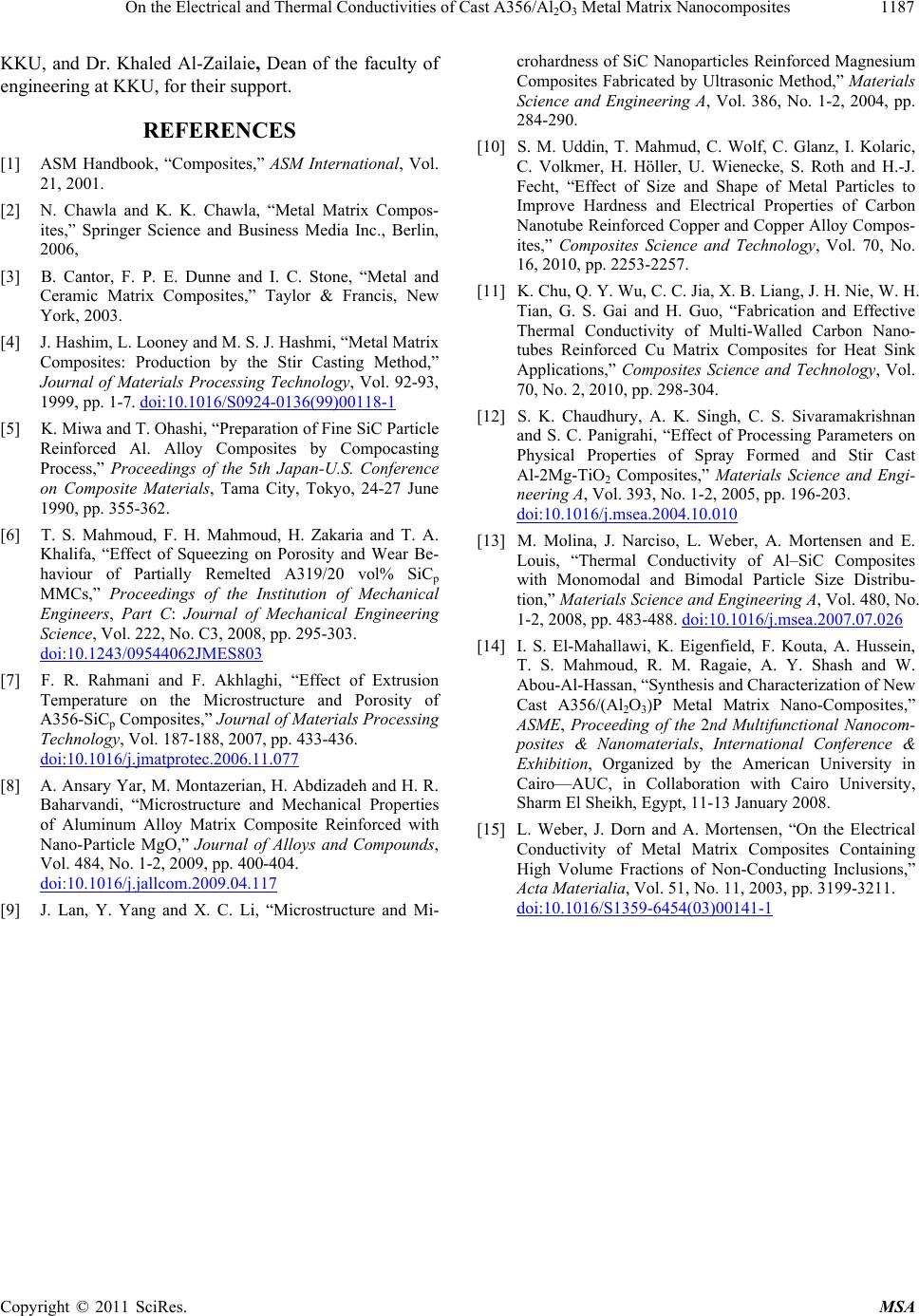
On the Electrical and Thermal Conductivities of Cast A356/Al2O3 Metal Matrix Nanocomposites
Copyright © 2011 SciRes. MSA
1187
KKU, and Dr. Khaled Al-Zailaie, Dean of the faculty of
engineering at KKU, for their support.
REFERENCES
[1] ASM Handbook, “Composites,” ASM International, Vol.
21, 2001.
[2] N. Chawla and K. K. Chawla, “Metal Matrix Compos-
ites,” Springer Science and Business Media Inc., Berlin,
2006,
[3] B. Cantor, F. P. E. Dunne and I. C. Stone, “Metal and
Ceramic Matrix Composites,” Taylor & Francis, New
York, 2003.
[4] J. Hashim, L. Looney and M. S. J. Hashmi, “Metal Matrix
Composites: Production by the Stir Casting Method,”
Journal of Materials Processing Technology, Vol. 92-93,
1999, pp. 1-7. doi:10.1016/S0924-0136(99)00118-1
[5] K. Miwa and T. Ohashi, “Preparation of Fine SiC Particle
Reinforced Al. Alloy Composites by Compocasting
Process,” Proceedings of the 5th Japan-U.S. Conference
on Composite Materials, Tama City, Tokyo, 24-27 June
1990, pp. 355-362.
[6] T. S. Mahmoud, F. H. Mahmoud, H. Zakaria and T. A.
Khalifa, “Effect of Squeezing on Porosity and Wear Be-
haviour of Partially Remelted A319/20 vol% SiCp
MMCs,” Proceedings of the Institution of Mechanical
Engineers, Part C: Journal of Mechanical Engineering
Science, Vol. 222, No. C3, 2008, pp. 295-303.
doi:10.1243/09544062JMES803
[7] F. R. Rahmani and F. Akhlaghi, “Effect of Extrusion
Temperature on the Microstructure and Porosity of
A356-SiCp Composites,” Journal of Materials Processing
Technology, Vol. 187-188, 2007, pp. 433-436.
doi:10.1016/j.jmatprotec.2006.11.077
[8] A. Ansary Yar, M. Montazerian, H. Abdizadeh and H. R.
Baharvandi, “Microstructure and Mechanical Properties
of Aluminum Alloy Matrix Composite Reinforced with
Nano-Particle MgO,” Journal of Alloys and Compounds,
Vol. 484, No. 1-2, 2009, pp. 400-404.
doi:10.1016/j.jallcom.2009.04.117
[9] J. Lan, Y. Yang and X. C. Li, “Microstructure and Mi-
crohardness of SiC Nanoparticles Reinforced Magnesium
Composites Fabricated by Ultrasonic Method,” Materials
Science and Engineering A, Vol. 386, No. 1-2, 2004, pp.
284-290.
[10] S. M. Uddin, T. Mahmud, C. Wolf, C. Glanz, I. Kolaric,
C. Volkmer, H. Höller, U. Wienecke, S. Roth and H.-J.
Fecht, “Effect of Size and Shape of Metal Particles to
Improve Hardness and Electrical Properties of Carbon
Nanotube Reinforced Copper and Copper Alloy Compos-
ites,” Composites Science and Technology, Vol. 70, No.
16, 2010, pp. 2253-2257.
[11] K. Chu, Q. Y. Wu, C. C. Jia, X. B. Liang, J. H. Nie, W. H.
Tian, G. S. Gai and H. Guo, “Fabrication and Effective
Thermal Conductivity of Multi-Walled Carbon Nano-
tubes Reinforced Cu Matrix Composites for Heat Sink
Applications,” Composites Science and Technology, Vol.
70, No. 2, 2010, pp. 298-304.
[12] S. K. Chaudhury, A. K. Singh, C. S. Sivaramakrishnan
and S. C. Panigrahi, “Effect of Processing Parameters on
Physical Properties of Spray Formed and Stir Cast
Al-2Mg-TiO2 Composites,” Materials Science and Engi-
neering A, Vol. 393, No. 1-2, 2005, pp. 196-203.
doi:10.1016/j.msea.2004.10.010
[13] M. Molina, J. Narciso, L. Weber, A. Mortensen and E.
Louis, “Thermal Conductivity of Al–SiC Composites
with Monomodal and Bimodal Particle Size Distribu-
tion,” Materials Science and Engineering A, Vol. 480, No.
1-2, 2008, pp. 483-488. doi:10.1016/j.msea.2007.07.026
[14] I. S. El-Mahallawi, K. Eigenfield, F. Kouta, A. Hussein,
T. S. Mahmoud, R. M. Ragaie, A. Y. Shash and W.
Abou-Al-Hassan, “Synthesis and Characterization of New
Cast A356/(Al2O3)P Metal Matrix Nano-Composites,”
ASME, Proceeding of the 2nd Multifunctional Nanocom-
posites & Nanomaterials, International Conference &
Exhibition, Organized by the American University in
Cairo—AUC, in Collaboration with Cairo University,
Sharm El Sheikh, Egypt, 11-13 January 2008.
[15] L. Weber, J. Dorn and A. Mortensen, “On the Electrical
Conductivity of Metal Matrix Composites Containing
High Volume Fractions of Non-Conducting Inclusions,”
Acta Materialia, Vol. 51, No. 11, 2003, pp. 3199-3211.
doi:10.1016/S1359-6454(03)00141-1